Meng Qin
Towards Faster Graph Partitioning via Pre-training and Inductive Inference
Sep 01, 2024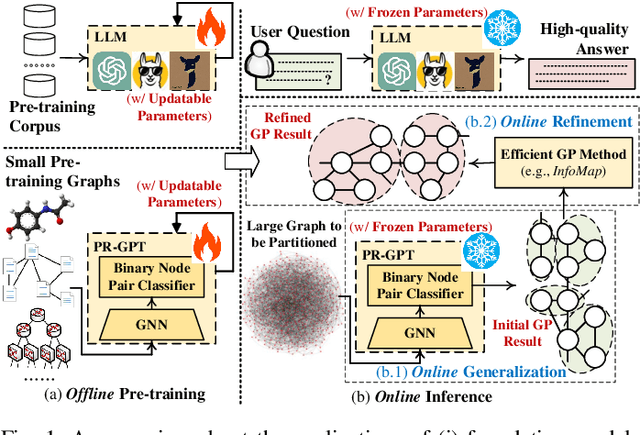
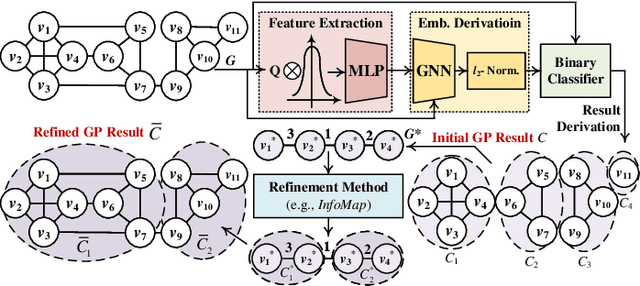


Abstract:Graph partitioning (GP) is a classic problem that divides the node set of a graph into densely-connected blocks. Following the IEEE HPEC Graph Challenge and recent advances in pre-training techniques (e.g., large-language models), we propose PR-GPT (Pre-trained & Refined Graph ParTitioning) based on a novel pre-training & refinement paradigm. We first conduct the offline pre-training of a deep graph learning (DGL) model on small synthetic graphs with various topology properties. By using the inductive inference of DGL, one can directly generalize the pre-trained model (with frozen model parameters) to large graphs and derive feasible GP results. We also use the derived partition as a good initialization of an efficient GP method (e.g., InfoMap) to further refine the quality of partitioning. In this setting, the online generalization and refinement of PR-GPT can not only benefit from the transfer ability regarding quality but also ensure high inference efficiency without re-training. Based on a mechanism of reducing the scale of a graph to be processed by the refinement method, PR-GPT also has the potential to support streaming GP. Experiments on the Graph Challenge benchmark demonstrate that PR-GPT can ensure faster GP on large-scale graphs without significant quality degradation, compared with running a refinement method from scratch. We will make our code public at https://github.com/KuroginQin/PRGPT.
Semantic Random Walk for Graph Representation Learning in Attributed Graphs
May 11, 2023



Abstract:In this study, we focus on the graph representation learning (a.k.a. network embedding) in attributed graphs. Different from existing embedding methods that treat the incorporation of graph structure and semantic as the simple combination of two optimization objectives, we propose a novel semantic graph representation (SGR) method to formulate the joint optimization of the two heterogeneous sources into a common high-order proximity based framework. Concretely, we first construct an auxiliary weighted graph, where the complex homogeneous and heterogeneous relations among nodes and attributes in the original graph are comprehensively encoded. Conventional embedding methods that consider high-order topology proximities can then be easily applied to the newly constructed graph to learn the representations of both node and attribute while capturing the nonlinear high-order intrinsic correlation inside or among graph structure and semantic. The learned attribute embeddings can also effectively support some semantic-oriented inference tasks (e.g., semantic community detection), helping to reveal the graph's deep semantic. The effectiveness of SGR is further verified on a series of real graphs, where it achieves impressive performance over other baselines.
Trading off Quality for Efficiency of Community Detection: An Inductive Method across Graphs
Sep 29, 2022



Abstract:Many network applications can be formulated as NP-hard combinatorial optimization problems of community detection (CD). Due to the NP-hardness, to balance the CD quality and efficiency remains a challenge. Most existing CD methods are transductive, which are independently optimized only for the CD on a single graph. Some of these methods use advanced machine learning techniques to obtain high-quality CD results but usually have high complexity. Other approaches use fast heuristic approximation to ensure low runtime but may suffer from quality degradation. In contrast to these transductive methods, we propose an alternative inductive community detection (ICD) method across graphs of a system or scenario to alleviate the NP-hard challenge. ICD first conducts the offline training of an adversarial dual GNN on historical graphs to capture key properties of the system. The trained model is then directly generalized to new unseen graphs for online CD without additional optimization, where a better trade-off between quality and efficiency can be achieved. ICD can also capture the permutation invariant community labels in the offline training and tackle the online CD on new graphs with non-fixed number of nodes and communities. Experiments on a set of benchmarks demonstrate that ICD can achieve a significant trade-off between quality and efficiency over various baselines.
GCN-GAN: A Non-linear Temporal Link Prediction Model for Weighted Dynamic Networks
Jan 26, 2019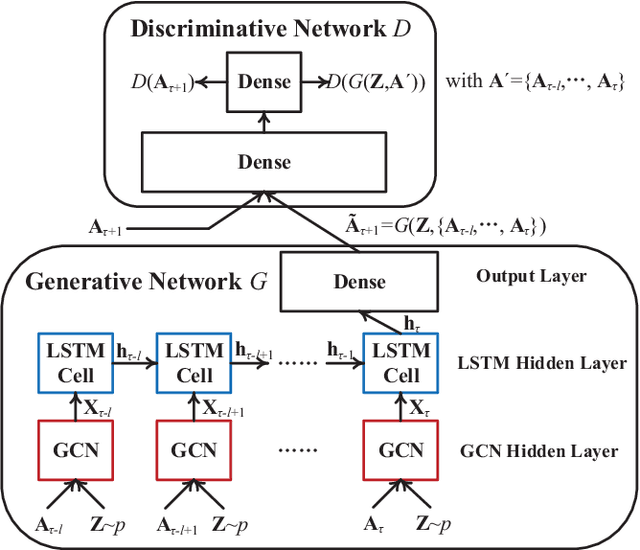
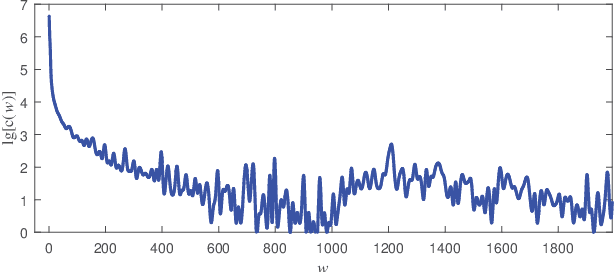
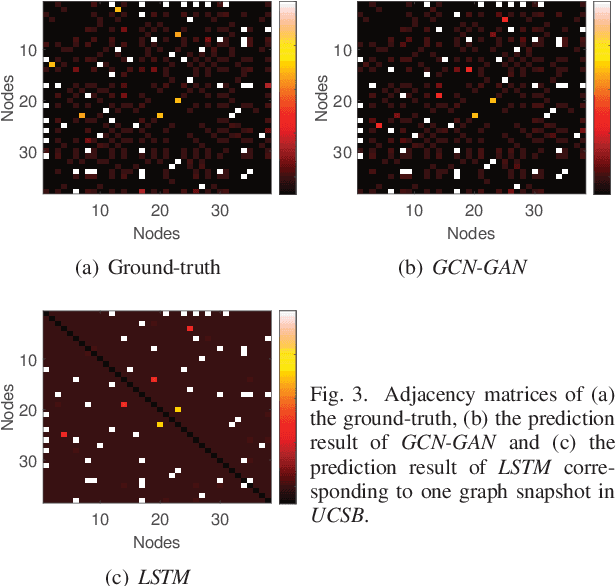
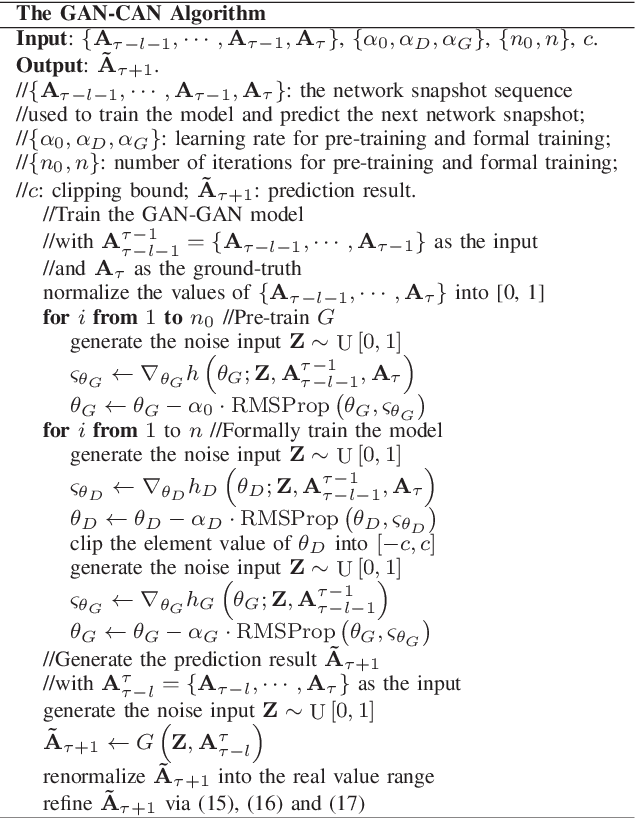
Abstract:In this paper, we generally formulate the dynamics prediction problem of various network systems (e.g., the prediction of mobility, traffic and topology) as the temporal link prediction task. Different from conventional techniques of temporal link prediction that ignore the potential non-linear characteristics and the informative link weights in the dynamic network, we introduce a novel non-linear model GCN-GAN to tackle the challenging temporal link prediction task of weighted dynamic networks. The proposed model leverages the benefits of the graph convolutional network (GCN), long short-term memory (LSTM) as well as the generative adversarial network (GAN). Thus, the dynamics, topology structure and evolutionary patterns of weighted dynamic networks can be fully exploited to improve the temporal link prediction performance. Concretely, we first utilize GCN to explore the local topological characteristics of each single snapshot and then employ LSTM to characterize the evolving features of the dynamic networks. Moreover, GAN is used to enhance the ability of the model to generate the next weighted network snapshot, which can effectively tackle the sparsity and the wide-value-range problem of edge weights in real-life dynamic networks. To verify the model's effectiveness, we conduct extensive experiments on four datasets of different network systems and application scenarios. The experimental results demonstrate that our model achieves impressive results compared to the state-of-the-art competitors.
 Add to Chrome
Add to Chrome Add to Firefox
Add to Firefox Add to Edge
Add to Edge